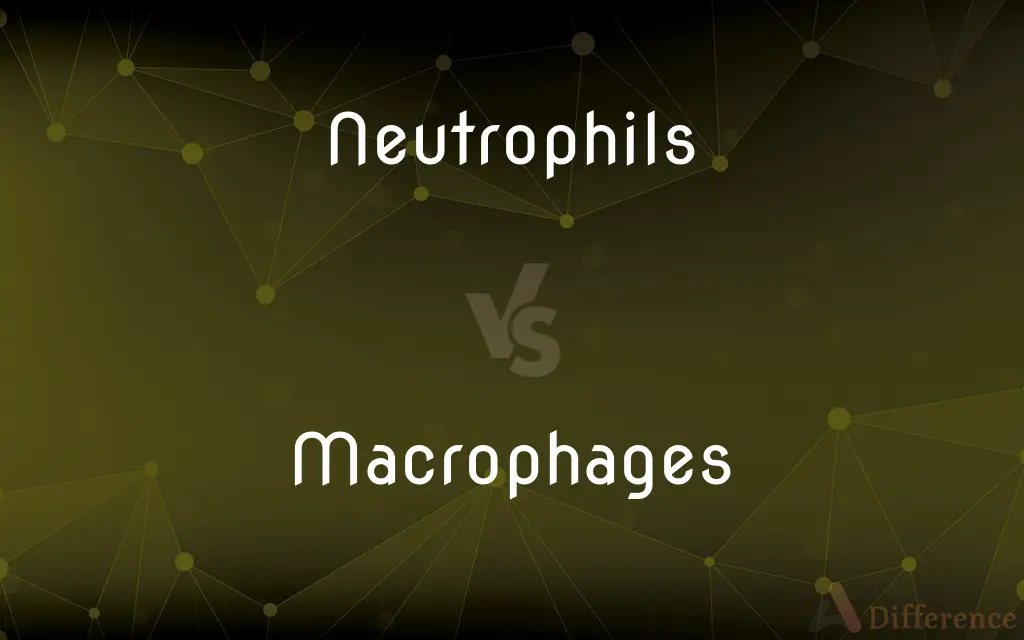Neutrophils vs. Macrophages — What's the Difference?
By Tayyaba Rehman — Published on October 19, 2023
Neutrophils are white blood cells that rapidly respond to infections; Macrophages are immune cells that engulf and digest pathogens and debris.

Difference Between Neutrophils and Macrophages
Table of Contents
ADVERTISEMENT
Key Differences
Neutrophils are the most common type of white blood cells in the bloodstream and are often the first to arrive at the site of an infection. Macrophages, on the other hand, are more versatile immune cells found throughout the body, particularly in tissues.
Neutrophils primarily target bacteria and fungi through phagocytosis, a process where they engulf and destroy these invaders. Macrophages are known for their ability to consume larger pathogens and cellular debris, making them crucial for cleaning up after infections and inflammation.
While Neutrophils have a shorter lifespan, typically lasting only a few hours to days, Macrophages can exist for longer periods, often transforming into tissue-resident cells that monitor and maintain the local environment.
The quick action of Neutrophils helps contain and combat early-stage infections. In contrast, Macrophages play a broader role in not only direct defense but also in tissue repair, immune response regulation, and the initiation of adaptive immunity.
Comparison Chart
Primary Function
Rapid response to infections
Engulf pathogens, debris; immune response regulation
ADVERTISEMENT
Location
Bloodstream
Throughout the body, especially in tissues
Targets
Mainly bacteria and fungi
Larger pathogens, cellular debris
Lifespan
Few hours to days
Longer, can become tissue-resident cells
Role in Immunity
Early-stage defense
Defense, tissue repair, adaptive immunity initiation
Compare with Definitions
Neutrophils
Neutrophils are the most abundant white blood cells.
Neutrophils act quickly to defend the body against bacterial infections.
Macrophages
Macrophages are found throughout the body.
Macrophages in the liver are known as Kupffer cells.
Neutrophils
Neutrophils primarily target bacteria and fungi.
Upon detecting bacteria, Neutrophils rush to the infection site.
Macrophages
Macrophages are immune cells involved in phagocytosis.
Macrophages play a key role in cleaning up dead cells and pathogens.
Neutrophils
Neutrophils have a short lifespan.
After battling pathogens, Neutrophils often undergo programmed cell death.
Macrophages
Macrophages contribute to tissue repair.
After an injury, Macrophages help in wound healing by removing debris.
Neutrophils
Neutrophils are granulocytes containing enzyme-filled granules.
The granules within Neutrophils release enzymes to destroy engulfed pathogens.
Macrophages
Macrophages have a role in both innate and adaptive immunity.
Macrophages can present antigens to T cells, initiating adaptive responses.
Neutrophils
Neutrophils engage in phagocytosis.
Neutrophils engulf and neutralize pathogens they encounter.
Macrophages
Macrophages are derived from monocytes.
When monocytes leave the bloodstream and enter tissues, they differentiate into Macrophages.
Neutrophils
A phagocytic, granulocytic white blood cell that occurs in large numbers in the blood, typically moving into tissue after injury or infection, where it destroys bacteria and other pathogens and releases cytokines.
Macrophages
Any of various large, phagocytic white blood cells that develop from monocytes, are found in the spleen, liver, and other tissues, and have a variety of functions in the immune system including engulfing and destroying pathogens and dead cells, presenting antigens to activate lymphocytes, and releasing cytokines that mediate inflammation.
Neutrophils
Neutrophilic.
Macrophages
Plural of macrophage
Neutrophils
Plural of neutrophil
Common Curiosities
Where are Macrophages commonly found?
Macrophages are found throughout the body, especially in tissues like the liver, lungs, and spleen.
How do Macrophages support adaptive immunity?
Macrophages can present antigens to T cells, thereby initiating adaptive immune responses.
Are Neutrophils and Macrophages both white blood cells?
Yes, both Neutrophils and Macrophages are types of white blood cells involved in immunity.
Which cell primarily targets bacteria?
Neutrophils primarily target bacteria, especially during the early stages of infections.
Do Neutrophils have a role in wound healing?
While Neutrophils primarily defend against pathogens, they can contribute to inflammation, which indirectly affects wound healing.
Do Neutrophils and Macrophages use the same mechanisms to destroy pathogens?
Both employ phagocytosis, but they utilize different enzymes and processes based on the pathogens they target.
Can Macrophages transform into other cell types?
Yes, Macrophages can differentiate into specific tissue-resident cells, like Kupffer cells in the liver.
Which cells play a broader role in overall immunity?
Macrophages play a broader role, including defense, tissue repair, and immune response regulation.
Are Neutrophils present for longer durations at infection sites?
No, Neutrophils have a shorter lifespan, often undergoing cell death after combating pathogens.
Share Your Discovery

Previous Comparison
Sumerians vs. Egyptians
Next Comparison
Detergent vs. Washing PowderAuthor Spotlight
Written by
Tayyaba RehmanTayyaba Rehman is a distinguished writer, currently serving as a primary contributor to askdifference.com. As a researcher in semantics and etymology, Tayyaba's passion for the complexity of languages and their distinctions has found a perfect home on the platform. Tayyaba delves into the intricacies of language, distinguishing between commonly confused words and phrases, thereby providing clarity for readers worldwide.











































